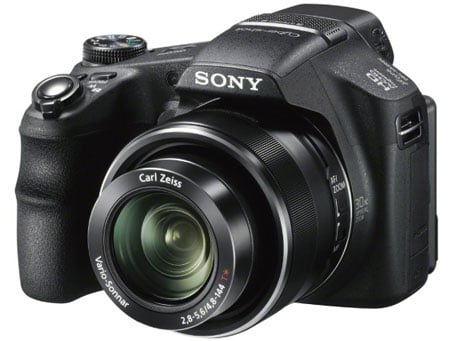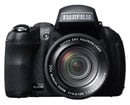Sony Cyber-shot HX200V review
-
-
Written by Ken McMahon
Verdict
The Sony Cyber-shot HX200V is a super-zoom camera with a a 30x stabilised optical zoom. It replaces the Cyber-shot HX100V, upping the sensor resolution to a whopping 18.2 megapixels. This new high resolution sensor, which Sony claims is the ‘highest resolution sensor currently offered in the mainstream “point and shoot” market’, appears in all models in Sony’s new ‘H-Series’ super-zoom range launched in February 2012 which includes the ultra-thin HX20V and HX30V.
As well as the new sensor, the HX200V boasts faster autofocus, inproved battery life and Clear Zoom – a digital zoom feature with enhanced interpolation that doubles the optical zoom range to an incredible 1620mm.
The HX200V retains the 22-810mm zoom range, 3 inch 921k dot articulated LCD screen and 0.5in 201k dot electronic viewfinder of its predecessor. In addiiton to PASM exposure modes it has many of the feature modes Sony is well-known for including the hand-held Twilight stacking and Backlight Correction stacking modes, High resolution Sweep Panorama, 3D shooting and a range of picture effects. And it’s very novice-friendly, with not one, but two Intelligent Auto modes and an In-Camera guide which interactively explains all of the HX200V’s functions and features. Finally, it has a built-in GPS reciever which automatically tags your photos with location information.
 |
Compared to Panasonic Lumix FZ60 / FZ62
The Sony Cyber-shot HX200V has a 30x zoom range that significantly outreaches the FZ60 / FZ62 at the telephoto end, but can’t match it’s 24mm equivalent super wide angle.
Both cameras offer a similar viewfinder experience, but the Cyber-shot’s LCD screen has a higher 921k resolution and is articulated. Also in its favour are the Cyber-shot HX200V’s continuous shooting modes, which offer the same 10fps full resolution speed, but for a longer 10-frame burst. Both cameras provide a range of effects filters as well as 3D shooting, but on the FZ60 / FZ62 you can put them to use while recording movies, that’s not an option on the Cyber-shot HX200V. If you want to be able to shoot panoramas, though, only the HX200V provides that option.
The HX200V also provides superior movie modes with a best quality 1080p50/60 mode, with, like the FZ60 / FZ62, the option of AVCHD or MPEG-4 encoding. If you want control over exposure during moving shooting the FZ60 / FZ62 provides it, with access to the full range of PASM exposure modes, whereas with the HX200V you’re restricted to Intelligent Auto mode or a choice of scene modes.
At 18.2 Megapixels The HX200V’s CMOS sensor produces images that are a little larger than those from the FZ60 / FZ62, but lagged behind slightly in my outdoor resolution test and performed poorly in high ISO noise test results. Finally, the HX200V has a built-in GPS receiver that tags images with geopositional information – a useful feature for those looking for a camera to take on their travels.
With a bigger zoom, 1080p HD movies, better continuous shooting and GPS, the HX200V looks to be a winner, but it is a little more expensive than the FZ60 / FZ62 and it may be that none of those features a priority for you, in which case the FZ60 / FZ62 could prove a better value buy.
See my Panasonic FZ60 / FZ62 review for more details.
Compared to Fujifilm FinePix HS30 EXR
The Sony Cyber-shot HX200V matches the FinePix HS30 EXR for zoom range, but its stabilised 30X optical zoom starts with a narrower 27mm equivalent focal length and extends 90mm further to 810mm, so if it’s reach you’re looking for, the HX200V will get you significantly closer to your subject. Both cameras have a 3 inch articulated screen hinged in an almost identical fashion. Though the HX200V’s has a higher resolution 921k dot screen, the HS30 EXR’s is much easier to see outdoors in bright light. Switch to the electronic viewfinder and the HS30 EXR provides a bigger brighter more detailed view.
The HS30 can shoot RAW, has an abundance of physical controls, a manually operated zoom barrel and a hotshoe for mounting an external flash, all things which might endear it more to those looking for SLR-style handling. The HX200V on the other hand is smaller, lighter and better looking than the HS30 EXR. It has a motorised zoom which is more useful for movie shooting plus you can manually zoom (via a motorised coupling) if you want. Though it lacks the HS30 EXR’s RAW mode and its eponymous shooting modes, it has plenty of its own including Hand-held Twilight, panorama, 3D modes, and a range of Picture Effect options. It also features a built-in GPS reciever that tags your images with the current geographic location.
The HX200V also provides superior movie modes with a best quality 1080p50/60 mode, with the option of AVCHD or MPEG-4 encoding. Finally, the HX200V has a higher resolution 18.2 Megapixel CMOS sensor, but my tests revealed that the overall quality and low light performance of the HX200V wasn’t quite as good as the 16 Megapixel FinePix HS30 EXR.
See my Fujifilm HS30 EXR review for more details.
Sony Cyber-shot HX200V verdict
The Sony Cyber-shot HX200V is a camera that’s hard not to like. It has some little niggles which can infuriate, like the lens cap that stops the lens from extending when you switch it on and the interminably long main menu, but it makes up for those shortcomings in so many ways. Small things like the In-Camera guide, the eye sensor and the manual focus/zoom ring all go to make a camera that’s a pleasure to use from a handling standpoint. These are things that don’t jump out at you from a spec sheet, but can end up being the things that matter most.
But it’s features and specifications that sell cameras and the HX200V has plenty to offer here too. Its 30x optical zoom range beats both the Lumix FZ60 / FZ62 and the FinePix HS30 EXR, at the telephoto end at least. It offers an unparalleled 1080p50/60 best quality movie mode and full resolution 10fps continuous shooting for a 10-frame burst. Add a GPS receiver into the mix and the HX200V begins to look like a very compelling buy.
Interestingly, all of those features are ones that were previously on offer from the earlier HX100V. And what could be considered the HX200V’s biggest new feature – the 18.2 megapixel sensor is actually its Achilles heel. The higher resolution sensor performed worse in my outdoor resolution and High ISO noise tests than the competition and, in my view, is a backward step.
Of course at less than 100 percent view you’re unlikely to notice these differences. It’s only if you make the huge A2-sized prints that an 18.2 megapixel sensor is capable of supporting that you’ll notice the less than optimal quality. I wonder if the irony of that is lost on Sony? One thing is obvious, while stocks remain, now is a very good time to get your hands on an HX100V.
Bad points | Scores (relative to 2012 super-zooms) | |||
Build quality: Image quality: Handling: Specification: Value:
Overall: |
17 / 20 17 / 20 16 / 20 15 / 20 16 / 20
81% | |||






